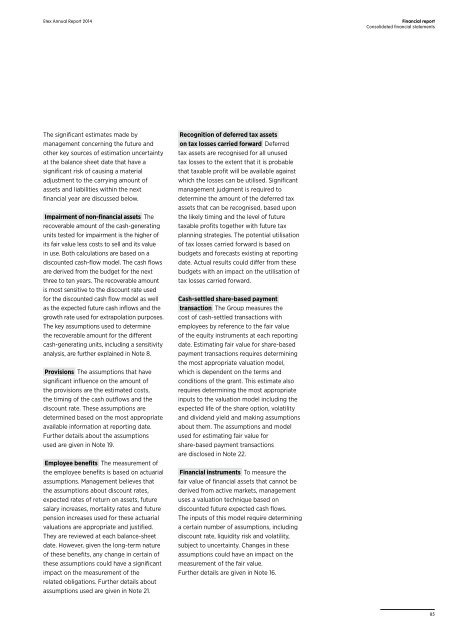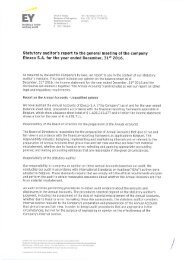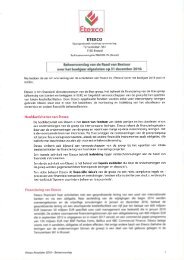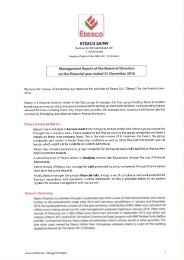Annual Report 2014
This is the 2014 annual report of Etex Group
This is the 2014 annual report of Etex Group
You also want an ePaper? Increase the reach of your titles
YUMPU automatically turns print PDFs into web optimized ePapers that Google loves.
Etex <strong>Annual</strong> <strong>Report</strong> <strong>2014</strong><br />
Financial report<br />
Consolidated financial statements<br />
The significant estimates made by<br />
management concerning the future and<br />
other key sources of estimation uncertainty<br />
at the balance sheet date that have a<br />
significant risk of causing a material<br />
adjustment to the carrying amount of<br />
assets and liabilities within the next<br />
financial year are discussed below.<br />
Impairment of non-financial assets The<br />
recoverable amount of the cash-generating<br />
units tested for impairment is the higher of<br />
its fair value less costs to sell and its value<br />
in use. Both calculations are based on a<br />
discounted cash-flow model. The cash flows<br />
are derived from the budget for the next<br />
three to ten years. The recoverable amount<br />
is most sensitive to the discount rate used<br />
for the discounted cash flow model as well<br />
as the expected future cash inflows and the<br />
growth rate used for extrapolation purposes.<br />
The key assumptions used to determine<br />
the recoverable amount for the different<br />
cash-generating units, including a sensitivity<br />
analysis, are further explained in Note 8.<br />
Provisions The assumptions that have<br />
significant influence on the amount of<br />
the provisions are the estimated costs,<br />
the timing of the cash outflows and the<br />
discount rate. These assumptions are<br />
determined based on the most appropriate<br />
available information at reporting date.<br />
Further details about the assumptions<br />
used are given in Note 19.<br />
Employee benefits The measurement of<br />
the employee benefits is based on actuarial<br />
assumptions. Management believes that<br />
the assumptions about discount rates,<br />
expected rates of return on assets, future<br />
salary increases, mortality rates and future<br />
pension increases used for these actuarial<br />
valuations are appropriate and justified.<br />
They are reviewed at each balance-sheet<br />
date. However, given the long-term nature<br />
of these benefits, any change in certain of<br />
these assumptions could have a significant<br />
impact on the measurement of the<br />
related obligations. Further details about<br />
assumptions used are given in Note 21.<br />
Recognition of deferred tax assets<br />
on tax losses carried forward Deferred<br />
tax assets are recognised for all unused<br />
tax losses to the extent that it is probable<br />
that taxable profit will be available against<br />
which the losses can be utilised. Significant<br />
management judgment is required to<br />
determine the amount of the deferred tax<br />
assets that can be recognised, based upon<br />
the likely timing and the level of future<br />
taxable profits together with future tax<br />
planning strategies. The potential utilisation<br />
of tax losses carried forward is based on<br />
budgets and forecasts existing at reporting<br />
date. Actual results could differ from these<br />
budgets with an impact on the utilisation of<br />
tax losses carried forward.<br />
Cash-settled share-based payment<br />
transaction The Group measures the<br />
cost of cash-settled transactions with<br />
employees by reference to the fair value<br />
of the equity instruments at each reporting<br />
date. Estimating fair value for share-based<br />
payment transactions requires determining<br />
the most appropriate valuation model,<br />
which is dependent on the terms and<br />
conditions of the grant. This estimate also<br />
requires determining the most appropriate<br />
inputs to the valuation model including the<br />
expected life of the share option, volatility<br />
and dividend yield and making assumptions<br />
about them. The assumptions and model<br />
used for estimating fair value for<br />
share-based payment transactions<br />
are disclosed in Note 22.<br />
Financial instruments To measure the<br />
fair value of financial assets that cannot be<br />
derived from active markets, management<br />
uses a valuation technique based on<br />
discounted future expected cash flows.<br />
The inputs of this model require determining<br />
a certain number of assumptions, including<br />
discount rate, liquidity risk and volatility,<br />
subject to uncertainty. Changes in these<br />
assumptions could have an impact on the<br />
measurement of the fair value.<br />
Further details are given in Note 16.<br />
85

















